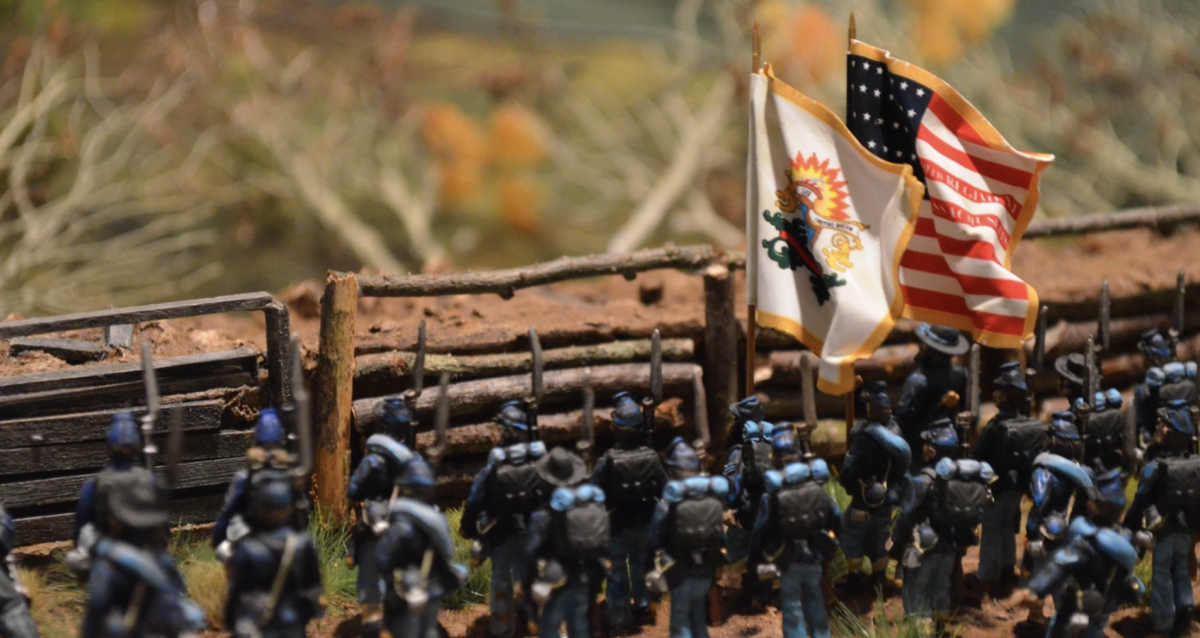Confederate Order of Battle, Franklin, TN (November 30, 1864)
Army of Tennessee, General John Bell Hood, commanding
INFANTRY
LEE’s Corps: Leut. Gen. Stephen D. Lee
Johnson’s Division: Maj. Gen. Edward Johnson
Deas’s Brigade: Brig. Gen. Zachariah C. Deas
19th, 22d, 25th, 39th, 50th Alabama
Manigault’s Brigade: Brig. Gen. Arthur M. Manigault, Lt. Col. William L. Butler (Nashville)
24th, 28th, 34th Alabama; 10th, 19th South Carolina
Sharp’s Brigade: Brig. Gen. Jacob H. Sharp
7th, 9th, 10th, 41st, 44th Mississippi
9th Battalion Mississippi Sharpshooters
Brantley’s Brigade: Brig. Gen. William F. Brantley
24th, 27th, 29th, 30th, 34th Mississippi
Dismounted Cavalry Company
Stevenson’s Division: Maj. Gen. Carter L. Stevenson
Cummings’s Brigade: Col. Elihu P. Watkins
24th, 36th, 39th, 56th Georgia
Pettus’s Brigade: Brig. Gen. Edmund W. Pettus
20th, 23d, 30th, 31st, 46th Alabama
Clayton’s Division: Maj. Gen. Henry D. Clayton
Stovall’s Brigade: Brig. Gen. Marcellus A. Stovall
40th, 41st, 42d, 43d, 52d Georgia
Gibson’s Brigade: Brig. Gen. Randall L. Gibson
1st, 4th, 13th, 16th, 19th, 20th, 25th, 30th Louisiana
4th Lousiana Battalion; 14th Lousiana Battalion Sharpshooters
Holtzclaw’s Brigade: Brig. Gen. James Holtzclaw
18th, 32d, 36th, 38th, 58th Alabama
STEWART’s Corps: Lt. Gen. Alexander P. Stewart
Loring’s Division: Maj. Gen. William W. Loring
Featherston’s Brigade: Brig. Gen. Winfield S. Featherston
1st, 3d, 22d, 31st, 33d, 40th Mississippi
1st Mississippi Battalion
Adams’s Brigade: Brig. Gen. John Adams; Col. Robert Lowry (Nashville)
6th, 14th, 15th, 20th, 23d, 43d Mississippi
Scott’s Brigade: Brig Gen Thomas M. Scott; Col. John Snodgrass (Nashville)
27th, 35th, 49th, 55th, 57th Alabama; 12th Louisiana
French’s Division: Maj. Gen. Samuel G. French, Brig. Gen. Claudius Sears
Ector’s Brigade: Col. David Coleman
29th, 30th North Carolina, 9th Texas
10th, 14th, 32d Texas Cavalry (dismounted)
Cockrell’s Brigade: Brig. Gen. F.M. Cockrell, brigade detached prior to Nashville under Col. Peter C. Flournoy
1st, 2nd, 3d, 4th, 5th, 6th Missouri
1st Missouri Cavalry (dismounted)
3d Missouri Cavalry Battalion (dismounted)
Sears’s Brigade: Brig. Gen. Claudius Sears, Lt. Col. Reuben H. Shotwell (Nashville)
4th, 35th, 36th, 39th, 46th Mississippi
7th Mississippi Battalion
Walthall’s Division: Maj. Gen. Edward C. Walthall
Quarles’s Brigade: Brig. Gen. William A. Quarles; Brig. Gen. George D.
Johnson (Nashville)
1st Alabama; 42d, 46th, 48th, 49th, 53d, 55th Tennessee
Cantley’s Brigade: Brig. Gen. Charles M. Shelley
17th, 26th, 29th Alabama; 37th Mississippi
Reynold’s Brigade: Brig. Gen. Daniel H. Reynolds
4th, 9th, 25th Arkansas
1st, 2d Arkansas Mounted Rifles (dismounted)
CHEATHAM’s Corps: Major General Benjamin F. Cheatham
Cleburne’s Division: Maj. Gen. Patrick Cleburne, Brig. Gen. James A. Smith (Nashville)
Lowrey’s Brigade: Brig. Gen. Mark P. Lowrey (Franklin)
16th, 33d, 45th Alabama; 5th, 8th, 32d Mississippi;
3d Mississippi Battalion
Govan’s Brigade: Brig. Gen. Daniel C. Govan
1st, 2d, 5th, 6th, 7th, 8th, 13th, 15th, 19th, 24th
Arkansas
Granbury’s Brigade: Brig. Gen. Hiram B. Granbury; Capt. E. T. Broughton
5th Confederate; 35th Tennessee; 6th, 7th, 10th, 15th Texas
17th, 18th, 24th, 25th Texas Cavalry (dismounted); Nutt’s Louisana Cavalry (dismounted)
Smith’s Brigade: on detached duty before Nashville-
Brig. Gen. James A. Smith; Col. Charles H. Olmstead
(Nashville)
54th, 57th, 63d Georgia; 1st Georgia Volunteers
Brown’s (Cheatham’s Old) Division: Maj. Gen. John C. Brown; Brig. Gen. Mark P. Lowrey (Nashville)
Gist’s Brigade: Brig. Gen. States Rights Gist; Lt. Col. Zachariah L. Watters (Nashville)
46th, 65th Georgia; 2d Battalion Georgia Sharpshooters; 16th, 24th South Carolina
Maney’s Brigade: Brig. Gen. John C. Carter; Col. Hume R. Field (Nashville)
1st, 4th (provisional), 6th, 8th, 9th, 16th, 27th, 28th, 50th Tennessee
Strahl’s Brigade: Brig. Gen. Otho F. Strahl; Col. AndrewJ. Kellar (Nashville)
4th, 5th, 19th, 24th, 31st, 33d, 38th, 41st Tennessee
Vaughan’s Brigade: Brig. Gen. George W. Gordon; Col. William M. Watkins (Nashville)
11th, 12th, 13th, 29th, 47th, 51st, 52nd, 154th Tennessee
Bate’s Division: Maj. Gen. William B. Bate
Tyler’s Brigade: Brig. Gen. Thomas B. Smith
37th Georgia; 4th Battalion Georgia Sharpshooters;
2d, 10th, 20th, 37th Tennessee
Finley’s Brigade: Col. Robert Bullock; Maj. Jacob A. Lash
1st, 3d, 4th, 6th, 7th Florida, 1st Florida Cavalry (dismounted)
Jackson’s Brigade: Brig. Gen. Henry R. Jackson
25th, 29th, 30th Georgia; 1st Georgia Confederate;
1st Battalion Georgia Sharpshooters
Artillery:
LEE’s Corps: 1) Col. Robert F. Beckham 2) Maj. John W. Johnston
Courtney’s Battalion: Capt. James P. Douglas
Dent’s Alabama Battery; Douglas’s Texas Battery; Garrity’s Alabama Battery
Eldridge’s Battalion: Capt. Charles E. Fenner
Eufaula Alabama Battery; Fenner’s Louisiana Battery; Stanford’s Miss Battery
Johnson’s Battalion: Capt. John B. Rowan
Corput’s Georgia Battery; Marshall’s Tenn Battery; Stephens’s Light Artillery
STEWART’s Corps: Lt. Col. Samuel C. Williams
Truehart’s Battalion:
Lumsden’s Alabama Battery; Selden’s Alabama Battery
Myrick’s Battalion:
Bouanchaud’s Louisiana Battery; Cowan’s Miss Battery,
Darden’s Miss Battery
Storrs’ Battalion:
Guiborps Missouri Battery; Hoskin’s Miss Battery; Kolb’s Alabama Battery
CHEATHAM’s Corps: Col. Melancthon Smith
Hoxton’s Battalion:
Perry’s Florida Battery; Phelan’s Alabama Battery; Turner’s Miss Battery
Hotchkiss’s Battalion:
Bledsoe’s Missouri Battery; Goldtwaite’s Alabama Battery; Key’s Arkansas Battery
Cobb’s Battalion:
Ferguson’s South Carolina Battery; Phillip’s [Mabane’s]
Cavalry: Maj. Gen. Nathan B. Forrest
CHALMER’s Division: Brig. Gen. James R. Chalmers
Rucker’s Brigade: Col. Edmund W. Rucker
7th Alabama Cavalry; 5th Miss Cavalry; 7th, 12th, 14th, 15th Tenn Cavalry; Forrest’s Regiment Tenn Cavalry
Biffle’s Brigade: Col. Jacob B. Biffle, 10th Tenn Cavalry
BUFORD’s Division: Brig. Gen. Abraham Buford
Bell’s Brigade: Col. Tyree H. Bell
2d, 19th, 20th, 21st Tenn Cavalry; Nixon’s Tenn Cavalry Regiment
Crossland’s Brigade: Col. Edward Crossland
3d, 7th, 8th, 12th Kentucky Mounted Infantry;
12th Kentucky Cavalry; Huey’s Kentucky Battalion
JACKSON’s Division: Brig. Gen. William H. Jackson
Armstrong’s Brigade: Brig. Gen. Frank C. Armstrong
1st, 2d, 28th Miss Cavalry; Ballentine’s Miss Regiment
Ross’s Brigade: Brig. Gen. Lawrence S. Ross
5th, 6th, 9th Texas Cavalry; 1st Texas Legion
ARTILLERY
Morton’s Tennesse Battery, Slocumb’s Louisiana Battery





